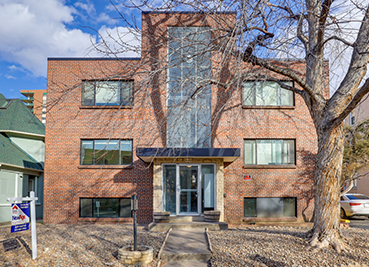
As seen in Colorado Real Estate Journal
As we venture into 2024, the metro Denver small multifamily market continues to navigate through a landscape shaped by economic adjustments, evolving housing demands and a transforming real estate sector. The multifamily sector, particularly the small multifamily market, usually defined as properties with less than 50 units, always has been a dynamic segment of the real estate industry in Colorado.
Over the last 10 years, the metro Denver small multifamily market has experienced an incredible growth. The market has become increasingly popular among investors due to its manageable size, robust rental demand, and lower barriers to entry compared to large multifamily investments. According to CoStar, the average market sale price per unit in the first quarter of 2014 was about $120,000. By the second quarter of 2022 the price has increased by nearly 220% when the average price per unit peaked at $262,196. In 2021, which was a record year for multifamily sales volume, some properties changed ownership multiple times. CoStar reported 941 small multifamily transaction records and 848 properties sold in 2021, which means some properties were sold more than once in one year.
Since the Fed launched its aggressive contractionary monetary policy in March 2022, the impact of the rapidly increasing borrowing costs changed the small multifamily market drastically. CoStar shows that in 2023 there were only 164 transaction records in metro Denver, a nearly 83% drop compared to 2021. High interest rates and stagnant rent growth along with skyrocketed operational costs made it hard to finance multifamily investments. The new market conditions put an upward pressure on cap rates, thus decreasing property valuations. The market cap rate in the first quarter of 2022 was at 4.73% and increased to 5.73% in the last quarter of 2023. We saw a dissonance between sellers and buyers where the sellers were still expecting 2021 valuations while the buyers were looking for a great deal.
As most investors stayed on the sidelines during the second half of 2022 and all of 2023, today, undeniably, there is some pent-up demand when it comes to multifamily investment. This year looks promising with the expectation that the Fed will cut the rate at least three times by the end of the year. Although the interest rates and operational costs are still high, the fundamentals underpinning demand are still here. Let’s look at the key considerations that will impact the market going forward.
New Development
As far as the new supply goes, the metro Denver small multifamily segment is currently better positioned than the large multifamily sector. The current inventory of the metro Denver small multifamily market consists of 4,635 properties with a total of 54,114 units. 451 units are under construction with only 80 units projected to be delivered this year. This is a tiny fraction compared to 30,496 large multifamily units that are currently being built and 11,672 units projected for deliveries in 2024. The large apartment market is expected to expand by roughly 10% in the next few years, while the small multifamily market will grow by less than 1%. This drastic difference in new supply volume is reflected in the vacancy rates, currently at 4.9% for small multifamily properties and 8.2% for large apartment buildings.
Affordability
Metro Denver has a drastic shortage of affordable housing and most likely will continue to experience that for the next several years. According to CoStar, about 77% of existing small multifamily inventory is characterized as Class C, a category that offers most affordability and, therefore, the demand for the small multifamily rentals will continue.
Demographics
Although the net migration to metro Denver has slowed in the past couple of years, the population growth projections look strong. Per Macrotrends, the current metro Denver population is more than 2.96 million. According to the Metro Denver Economic Development Corp., by 2030 this number is projected to increase by roughly 22% to 3.63 million. Given the slowing starts for new construction and high cost of ownership, the demand for rentals in general and affordable rentals, in particular, will remain robust.
Economy
Colorado and metro Denver continue to enjoy a diverse and resilient economy, thriving on a mix of industries including technology, health care and finance. Although the unemployment rate in Colorado has been ticking up throughout 2023 and increased to 3.4% in December, it is still lower than national unemployment rate of 3.7%. Overall, Colorado’s economy continues to outperform most states as far as unemployment, labor force, population and gross domestic product growth.
Rental Market
CoStar projects that rent in the small multifamily segment will increase by 3.8% in 2024, which is an improvement from 1.5% growth in 2023. The average market asking rent per unit for fourth-quarter 2023 was $1,252 and is projected to go up to $1,300 by the fourth quarter of this year. Although the rent growth has slowed in the past year and a half, the cash flow levels remain healthy due to low vacancy rates and high rent collections. Chandan Economics report for October 2023 estimated that the tenants in small multifamily units paid their full rent in 90.6% of units, one of the highest on-time payment rates in the country.
Delinquencies
The data indicate low risk for delinquencies in 2024. There are only 19 small multifamily properties that have loans that will mature in 2024 and 2025. Moreover, currently there are only six properties in metro Denver that are reported as delinquent.
In 2024 the small multifamily market will continue to navigate the challenges such as tight underwriting standards, high operating costs relative the rents collected, increasing cap rates and modest rent growth. Supported by the strong rental demand and healthy cash flows, the segment is starting to show the signs of stabilization as reflected in a recently increased market activity. As the fears of recession are starting to subside and market sentiment improves, this dynamic segment will continue to offer rewarding opportunities for those ready to seize them.




